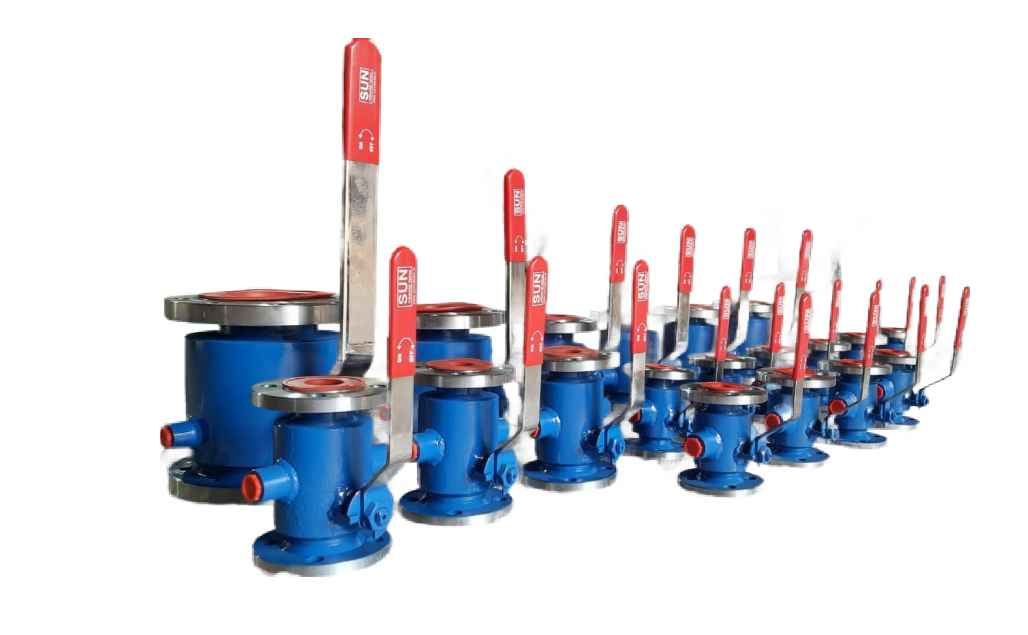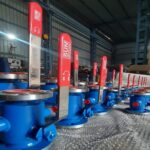Jacketed Ball Valve
SUN’s jacketed ball valve is a type of valve that has a protective outer layer, or “jacket,” around its body. This jacket lets a heating or cooling fluid (like steam or hot water) flow around the valve, helping to control the temperature of whatever liquid or gas is passing through it. This is especially useful in situations where the temperature of the material is important, such as with thick liquids, chemicals, or in environments with extreme temperatures.
The main job of the jacket is to keep the fluid inside the valve at the right temperature, making sure it doesn’t freeze, harden, or form crystals. These valves are commonly used in industries like chemicals, food and beverage, pharmaceuticals, and oil and gas, where temperature control is crucial for safe and efficient operations.
Chemical Processing:
To handle viscous, temperature-sensitive chemicals, ensuring the material stays at an optimal temperature during transport through the piping.
Food and Beverage:
In industries where materials like chocolate, syrup, or dairy products need to maintain a certain temperature to avoid crystallization or solidification.
Pharmaceutical:
Ensuring that chemicals or medicines, especially those that are sensitive to temperature changes, remain at their required processing temperatures.
Oil & Gas:
Preventing freezing or excessive heating of hydrocarbons or other liquids in pipelines or during storage and transport, particularly in cold climates.
Pulp and Paper:
Handling chemicals and pulp that require stable temperatures for processing.
Polymer Production:
For controlling temperature in the flow of polymers, preventing solidification or degradation during processing.
Temperature Control:
The jacket allows for precise temperature management, preventing freezing, solidification, or degradation of materials, especially in sensitive processes.
Improved Process Efficiency:
By maintaining the right temperature, the valve ensures that materials like thick liquids or chemicals flow smoothly, enhancing overall system efficiency and reducing downtime.
Protection of Sensitive Materials:
Ideal for handling temperature-sensitive substances such as chemicals, food products, and pharmaceuticals, ensuring they remain within safe temperature ranges.
Versatility:
Jacketed ball valves can be used in a wide range of industries, including chemicals, food processing, pharmaceuticals, and oil & gas, making them suitable for many different applications.
Energy Efficiency:
The jacket helps reduce energy loss by maintaining the desired temperature of the fluid, saving energy in heating or cooling systems.
Prevention of Crystallization:
In applications where substances may crystallize or harden (like in high-viscosity fluids), the jacket keeps the material flowing and operational.
Enhanced Safety:
The jacketed design can prevent accidents in hazardous environments by controlling temperature and reducing the risks of process failures due to temperature fluctuations.
Durability and Corrosion Resistance:
These valves are built to withstand harsh conditions, often made from corrosion-resistant materials that ensure long-term performance and reliability.
Adaptability for Automated Systems:
Jacketed ball valves can be easily integrated with automated control systems, improving process automation and reducing the need for manual operation.
| Specification | Details |
|---|---|
| Size Range | Typically from 1/2″ to 24″ (DN 15 to DN 600) |
| Pressure Rating | ANSI Class 150, 300, 600, or custom (depending on design) |
| Temperature Range | -20°F to 750°F (-29°C to 400°C), depending on the jacket material and design |
| Material of Construction | Body: Carbon steel, Stainless steel, Alloy materials; Jacket: Carbon steel, Stainless steel, or other corrosion-resistant materials |
| End Connections | Flanged, Threaded, Welded, or Clamp connection |
| Valve Type | Full port, Reduced port, 2-way or 3-way |
| Seal Type | PTFE, PEEK, Graphite, or elastomeric seals |
| Jacket Pressure | 50 psi to 150 psi (3.5 bar to 10 bar), depending on jacket design |
| Flow Coefficient (Cv) | Varies based on valve size, typically from 1 to 200+ |
| Actuation Options | Manual, Pneumatic, Electric, Hydraulic |
| Body Design | Two-piece or three-piece design |
| Design Standard | ASME, API, ISO, DIN (varies by region and application) |
The outer jacket allows for the circulation of heating or cooling fluid (such as steam or hot water) around the valve, helping to maintain or control the temperature of the fluid inside the valve, preventing freezing, solidification, or crystallization.
Jacketed ball valves are typically made from high-quality materials like stainless steel, carbon steel, or alloy materials for both the valve body and jacket, ensuring strength, corrosion resistance, and reliability in harsh environments.
The valve includes high-performance seals (such as PTFE or elastomers) that prevent leaks even under high pressure or extreme temperature conditions, ensuring safe and efficient operation in critical processes.







